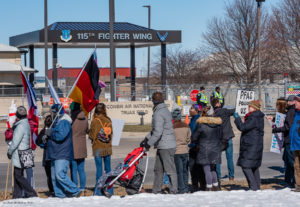Cap Times Editorial: The Fight Against F-35s is Far from Finished

Capital Times Editorial, 3 March 2021

[note: the struggle here involves stopping the F-35’s but also to stop the toxic pollution by forever chemicals and have those responsible clean up the pollution of our soil and water]
“Members of the Dane County Board of Supervisors are again wrestling with questions about how to rethink, challenge and potentially oppose placement of a squadron of F-35 fighter jets at Madison’s Truax Field.
Last Thursday, the board’s Environment, Agriculture and Natural Resources Committee voted to recommend a resolution opposing the F-35s. If the full board approves that resolution, Dane County will officially go on record in support of delaying construction agreements. And the county’s legal department will be directed to explore strategies for blocking the F-35s and, if that is not possible, in mitigating the impact of jet noise and other concerns.
That won’t necessarily block the F-35s from coming to Madison. But it will put the county on the right side of a debate that is far from finished.
Mounting concerns about the viability of the F-35 project demand that the county — and the Madison Common Council, which last year expressed its opposition to the F-35s — revisit the issue of whether this region should stake any part of its future on a plane that Popular Mechanics once described as “a symbol of everything that’s wrong with mammoth defense contracts: behind schedule, over budget, and initially over-sold.”

We understand that there are F-35 enthusiasts who suggest that the issue should not be taken up because it was “settled” last April. That’s when the U.S. Air Force selected Madison to host the F-35s, despite widespread opposition from Madisonians who expressed concern about jet noise and other disruptions that might be caused by the decision to replace aging F-16s with the new planes at the Wisconsin Air National Guard’s 115th Fighter Wing.
But the people who think this fight is over should pay closer attention to the latest developments in the torturous saga of the Air Force’s effort to develop next-generation fighter jets.
It’s no secret that the F-35 project has been an expensive — make that, exceptionally expensive — boondoggle. The New York Times calls it “dysfunctional.” Fortune magazine calls the program that has attempted to develop it “a mess.” Salon says, “Somehow the United States has managed to develop a fighter jet for all three services — the Air Force, Navy and Marines — that goes for $100 million apiece, ran up almost a half-trillion dollars in total development costs, will cost almost $2 trillion over the life of the plane, and yet it can’t be flown safely.”
So it came as no great surprise, last week, when Air Force Chief of Staff Gen. Charles Q. Brown announced a plan to review the F-35 project. He framed the initiative in predictably bureaucratic language. But Forbes magazine — not exactly an anti-war publication — headlined its story of Brown’s move: “The U.S. Air Force Just Admitted The F-35 Stealth Fighter Has Failed.”
“Fifteen years after the F-35’s first flight, the Air Force has just 250 of the jets. Now the service is signaling possible cuts to the program. It’s not for no reason that Brown has begun characterizing the F-35 as a boutique, high-end fighter in the class of the F-22. The Air Force ended F-22 production after completing just 195 copies,” reported Forbes aerospace and defense writer David Axe. “The Air Force could end F-35 production after just a few hundred examples and redirect tens of billions of dollars to a new fighter program.”
That news captured the attention of U.S. Rep. Mark Pocan, D-Town of Vermont, who wrote to Brown last week.
“While it has been made abundantly clear that Congress does not have authority over the USAF’s basing decisions, I am interested in how your recent comments may impact future placement of F-35A planes in Wisconsin,” Pocan said. “Considering your comments, and the Air Force’s concerns about the longevity and effectiveness of the F-35 planes, will the operational flaws of the F-35 and the upcoming tactical aviation review impact the current mission at Truax and the upcoming placement of F-35A planes at the base?”
Pocan held out the prospect of that an alternative use for the base might yet be found: “I stand ready to work with the USAF and Wisconsin Air National Guard to identify a different use for Truax Air Base that will improve the Air Force’s readiness and mission without significant interruption to surrounding neighborhoods and communities. I am also happy to discuss alternative missions for Truax, be it medical training, emergency response functions, or similarly situated activities.”
State Rep. Francesca Hong, D-Madison, supported Pocan’s letter, indicating that her office was prepared to work with the congressman and the Air Force to identify an alternative mission for Truax.
Pocan and Hong are right to recognize that the fight over F-35 is not done. The Dane County Board should join them in this recognition — and in signaling a willingness to working with the USAF and the Wisconsin Air National Guard in the discussion of alternative missions.”

